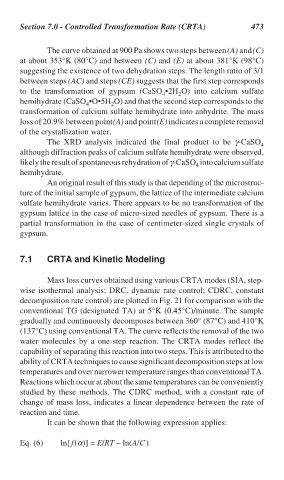Page 501 - Handbook of Thermal Analysis of Construction Materials
P. 501
Section 7.0 - Controlled Transformation Rate (CRTA) 473
The curve obtained at 900 Pa shows two steps between (A) and (C)
at about 353°K (80°C) and between (C) and (E) at about 381°K (98°C)
suggesting the existence of two dehydration steps. The length ratio of 3/1
between steps (AC) and steps (CE) suggests that the first step corresponds
to the transformation of gypsum (CaSO •2H O) into calcium sulfate
4
2
hemihydrate (CaSO •O•5H O) and that the second step corresponds to the
4 2
transformation of calcium sulfate hemihydrate into anhydrite. The mass
loss of 20.9% between point (A) and point (E) indicates a complete removal
of the crystallization water.
The XRD analysis indicated the final product to be γ-CaSO 4
although diffraction peaks of calcium sulfate hemihydrate were observed,
likely the result of spontaneous rehydration of γ-CaSO into calcium sulfate
4
hemihydrate.
An original result of this study is that depending of the microstruc-
ture of the initial sample of gypsum, the lattice of the intermediate calcium
sulfate hemihydrate varies. There appears to be no transformation of the
gypsum lattice in the case of micro-sized needles of gypsum. There is a
partial transformation in the case of centimeter-sized single crystals of
gypsum.
7.1 CRTA and Kinetic Modeling
Mass loss curves obtained using various CRTA modes (SIA, step-
wise isothermal analysis; DRC, dynamic rate control; CDRC, constant
decomposition rate control) are plotted in Fig. 21 for comparison with the
conventional TG (designated TA) at 5°K (0.45°C)/minute. The sample
gradually and continuously decomposes between 360° (87°C) and 410°K
(137°C) using conventional TA. The curve reflects the removal of the two
water molecules by a one-step reaction. The CRTA modes reflect the
capability of separating this reaction into two steps. This is attributed to the
ability of CRTA techniques to cause significant decomposition steps at low
temperatures and over narrower temperature ranges than conventional TA.
Reactions which occur at about the same temperatures can be conveniently
studied by these methods. The CDRC method, with a constant rate of
change of mass loss, indicates a linear dependence between the rate of
reaction and time.
It can be shown that the following expression applies:
Eq. (6) ln[f(α)] = E/RT – ln(A/C)

